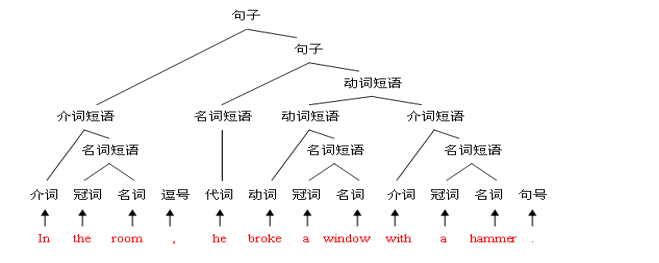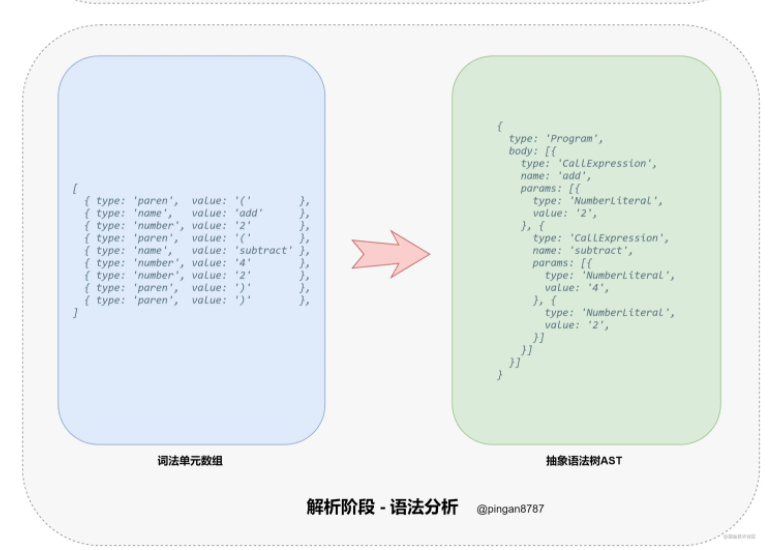>[success] # 語法分析 ( parsing)
~~~
1.語法分析器(parser)從詞法分析器輸出的token序列中識別出各類短語,并構造語法
分析樹(parse tree)
2.如圖我們將我們的 tokens 經過語法分析器變成一棵ast 語法樹
~~~

>[danger] ##### 圖形理解
~~~
1.將各個token標記成對應 ast 樹節點
[
{ type: 'paren', value: '(' },
{ type: 'name', value: 'add' },
{ type: 'number', value: '2' },
{ type: 'paren', value: '(' },
{ type: 'name', value: 'subtract' },
{ type: 'number', value: '4' },
{ type: 'number', value: '2' },
{ type: 'paren', value: ')' }, <<< Closing parenthesis
{ type: 'paren', value: ')' }, <<< Closing parenthesis
]
2.然后根據類型轉變生成對應ast 樹節點,舉個例子type:number
轉換對應ast 樹節點,類型應為
'NumberLiteral'
{
type: 'NumberLiteral',
value: token.value,
}
想變成這樣形式需要循環每一個token 詞,代碼對照情況
if (token.type === "number") {
current++;
return {
type: "NumberLiteral",
value: token.value,
};
}
當遇到括號時候其實就會形成遞歸 括號作為'CallExpression' 節點這個節點下又包括新的'NumericLiteral'
~~~
* 代碼如下
~~~
// 語法分析器 參數:詞法單元數組tokens
function parser(tokens) {
let current = 0; // 設置當前解析的詞法單元的索引,作為游標
// 遞歸遍歷(因為函數調用允許嵌套),將詞法單元轉成 LISP 的 AST 節點
function walk() {
// 獲取當前索引下的詞法單元 token
let token = tokens[current];
// 數值類型詞法單元
if (token.type === 'number') {
current++; // 自增當前 current 值
// 生成一個 AST節點 'NumberLiteral',表示數值字面量
return {
type: 'NumberLiteral',
value: token.value,
};
}
// 字符串類型詞法單元
if (token.type === 'string') {
current++;
// 生成一個 AST節點 'StringLiteral',表示字符串字面量
return {
type: 'StringLiteral',
value: token.value,
};
}
// 函數類型詞法單元
if (token.type === 'paren' && token.value === '(') {
// 跳過左括號,獲取下一個詞法單元作為函數名
token = tokens[++current];
let node = {
type: 'CallExpression',
name: token.value,
params: []
};
// 再次自增 current 變量,獲取參數詞法單元
token = tokens[++current];
// 遍歷每個詞法單元,獲取函數參數,直到出現右括號")"
while ((token.type !== 'paren') || (token.type === 'paren' && token.value !== ')')) {
node.params.push(walk());
token = tokens[current];
}
current++; // 跳過右括號
return node;
}
// 無法識別的字符,拋出錯誤提示
throw new TypeError(token.type);
}
// 初始化 AST 根節點
let ast = {
type: 'Program',
body: [],
};
// 循環填充 ast.body
while (current < tokens.length) {
ast.body.push(walk());
}
// 最后返回ast
return ast;
}
~~~

[圖片來自](https://juejin.cn/post/6844904105937207304#heading-12)
>[danger] ##### 以babel 生成ast語法樹 簡化了展示
~~~
// const a = 1
const a = {
program: {
type: "Program",
body: [
{
type: "VariableDeclaration",
declarations: [
{
type: "VariableDeclarator",
id: {
type: "Identifier",
name: "a",
},
init: {
type: "NumericLiteral",
value: 1,
},
},
],
kind: "const",
},
],
},
};
// a=1
const b = {
program: {
type: "Program",
body: [
{
type: "ExpressionStatement",
expression: {
type: "AssignmentExpression",
operator: "=",
left: {
type: "Identifier",
name: "a",
},
right: {
type: "NumericLiteral",
value: 1,
},
},
},
],
},
};
/**
* function a(str){
const z = str
console.log(z)
}
*
*/
const c = {
program: {
type: "Program",
body: [
{
type: "FunctionDeclaration",
id: {
type: "Identifier",
name: "a",
},
generator: false,
async: false,
params: [
{
type: "Identifier",
name: "str",
},
],
body: {
type: "BlockStatement",
body: [
{
type: "VariableDeclaration",
declarations: [
{
type: "VariableDeclarator",
id: {
type: "Identifier",
name: "z",
},
init: {
type: "Identifier",
name: "str",
},
},
],
kind: "const",
},
{
type: "ExpressionStatement",
expression: {
type: "CallExpression",
callee: {
type: "MemberExpression",
object: {
type: "Identifier",
name: "console",
},
computed: false,
property: {
type: "Identifier",
name: "log",
},
},
arguments: [
{
type: "Identifier",
name: "z",
},
],
},
},
],
},
},
],
},
};
~~~
>[danger] ##### 代碼
[直接用了 Babel是如何讀懂JS代碼的中的代碼](https://zhuanlan.zhihu.com/p/27289600)
~~~js
function parse (tokens) {
let i = -1; // 用于標識當前遍歷位置
let curToken; // 用于記錄當前符號
// 讀取下一個語句
function nextStatement () {
// 暫存當前的i,如果無法找到符合條件的情況會需要回到這里
stash();
// 讀取下一個符號
nextToken();
if (curToken.type === 'identifier' && curToken.value === 'if') {
// 解析 if 語句
const statement = {
type: 'IfStatement',
};
// if 后面必須緊跟著 (
nextToken();
if (curToken.type !== 'parens' || curToken.value !== '(') {
throw new Error('Expected ( after if');
}
// 后續的一個表達式是 if 的判斷條件
statement.test = nextExpression();
// 判斷條件之后必須是 )
nextToken();
if (curToken.type !== 'parens' || curToken.value !== ')') {
throw new Error('Expected ) after if test expression');
}
// 下一個語句是 if 成立時執行的語句
statement.consequent = nextStatement();
// 如果下一個符號是 else 就說明還存在 if 不成立時的邏輯
if (curToken === 'identifier' && curToken.value === 'else') {
statement.alternative = nextStatement();
} else {
statement.alternative = null;
}
commit();
return statement;
}
if (curToken.type === 'brace' && curToken.value === '{') {
// 以 { 開頭表示是個代碼塊,我們暫不考慮JSON語法的存在
const statement = {
type: 'BlockStatement',
body: [],
};
while (i < tokens.length) {
// 檢查下一個符號是不是 }
stash();
nextToken();
if (curToken.type === 'brace' && curToken.value === '}') {
// } 表示代碼塊的結尾
commit();
break;
}
// 還原到原來的位置,并將解析的下一個語句加到body
rewind();
statement.body.push(nextStatement());
}
// 代碼塊語句解析完畢,返回結果
commit();
return statement;
}
// 沒有找到特別的語句標志,回到語句開頭
rewind();
// 嘗試解析單表達式語句
const statement = {
type: 'ExpressionStatement',
expression: nextExpression(),
};
if (statement.expression) {
nextToken();
if (curToken.type !== 'EOF' && curToken.type !== 'sep') {
throw new Error('Missing ; at end of expression');
}
return statement;
}
}
// 讀取下一個表達式
function nextExpression () {
nextToken();
if (curToken.type === 'identifier') {
const identifier = {
type: 'Identifier',
name: curToken.value,
};
stash();
nextToken();
if (curToken.type === 'parens' && curToken.value === '(') {
// 如果一個標識符后面緊跟著 ( ,說明是個函數調用表達式
const expr = {
type: 'CallExpression',
caller: identifier,
arguments: [],
};
stash();
nextToken();
if (curToken.type === 'parens' && curToken.value === ')') {
// 如果下一個符合直接就是 ) ,說明沒有參數
commit();
} else {
// 讀取函數調用參數
rewind();
while (i < tokens.length) {
// 將下一個表達式加到arguments當中
expr.arguments.push(nextExpression());
nextToken();
// 遇到 ) 結束
if (curToken.type === 'parens' && curToken.value === ')') {
break;
}
// 參數間必須以 , 相間隔
if (curToken.type !== 'comma' && curToken.value !== ',') {
throw new Error('Expected , between arguments');
}
}
}
commit();
return expr;
}
rewind();
return identifier;
}
if (curToken.type === 'number' || curToken.type === 'string') {
// 數字或字符串,說明此處是個常量表達式
const literal = {
type: 'Literal',
value: eval(curToken.value),
};
// 但如果下一個符號是運算符,那么這就是個雙元運算表達式
// 此處暫不考慮多個運算銜接,或者有變量存在
stash();
nextToken();
if (curToken.type === 'operator') {
commit();
return {
type: 'BinaryExpression',
left: literal,
right: nextExpression(),
};
}
rewind();
return literal;
}
if (curToken.type !== 'EOF') {
throw new Error('Unexpected token ' + curToken.value);
}
}
// 往后移動讀取指針,自動跳過空白
function nextToken () {
do {
i++;
curToken = tokens[i] || { type: 'EOF' };
} while (curToken.type === 'whitespace');
}
// 位置暫存棧,用于支持很多時候需要返回到某個之前的位置
const stashStack = [];
function stash (cb) {
// 暫存當前位置
stashStack.push(i);
}
function rewind () {
// 解析失敗,回到上一個暫存的位置
i = stashStack.pop();
curToken = tokens[i];
}
function commit () {
// 解析成功,不需要再返回
stashStack.pop();
}
const ast = {
type: 'Program',
body: [],
};
// 逐條解析頂層語句
while (i < tokens.length) {
const statement = nextStatement();
if (!statement) {
break;
}
ast.body.push(statement);
}
return ast;
}
const ast = parse([
{ type: "whitespace", value: "\n" },
{ type: "identifier", value: "if" },
{ type: "whitespace", value: " " },
{ type: "parens", value: "(" },
{ type: "number", value: "1" },
{ type: "whitespace", value: " " },
{ type: "operator", value: ">" },
{ type: "whitespace", value: " " },
{ type: "number", value: "0" },
{ type: "parens", value: ")" },
{ type: "whitespace", value: " " },
{ type: "brace", value: "{" },
{ type: "whitespace", value: "\n " },
{ type: "identifier", value: "alert" },
{ type: "parens", value: "(" },
{ type: "string", value: "\"if 1 > 0\"" },
{ type: "parens", value: ")" },
{ type: "sep", value: ";" },
{ type: "whitespace", value: "\n" },
{ type: "brace", value: "}" },
{ type: "whitespace", value: "\n" },
]);
~~~
最終得到結果:
~~~js
{
"type": "Program",
"body": [
{
"type": "IfStatement",
"test": {
"type": "BinaryExpression",
"left": {
"type": "Literal",
"value": 1
},
"right": {
"type": "Literal",
"value": 0
}
},
"consequent": {
"type": "BlockStatement",
"body": [
{
"type": "ExpressionStatement",
"expression": {
"type": "CallExpression",
"caller": {
"type": "Identifier",
"value": "alert"
},
"arguments": [
{
"type": "Literal",
"value": "if 1 > 0"
}
]
}
}
]
},
"alternative": null
}
]
}
~~~
>[info] ## 參考文章
[Building a Debugger: Code Analysis](https://www.nan.fyi/debugger)
https://github1s.com/narendrasss/compiler/blob/main/src/parser.ts#L61
[Babel是如何讀懂JS代碼的](https://zhuanlan.zhihu.com/p/27289600)
[語法上用解析樹生根](https://medium.com/basecs/grammatically-rooting-oneself-with-parse-trees-ec9daeda7dad)
[# 【圖文詳解】200行JS代碼,帶你實現代碼編譯器(人人都能學會)](https://juejin.cn/post/6844904105937207304#heading-12)
https://github.com/YongzeYao/the-super-tiny-compiler-CN/blob/master/the-super-tiny-compiler.js
- 工程化 -- Node
- vscode -- 插件
- vscode -- 代碼片段
- 前端學會調試
- 谷歌瀏覽器調試技巧
- 權限驗證
- 包管理工具 -- npm
- 常見的 npm ci 指令
- npm -- npm install安裝包
- npm -- package.json
- npm -- 查看包版本信息
- npm - package-lock.json
- npm -- node_modules 層級
- npm -- 依賴包規則
- npm -- install 安裝流程
- npx
- npm -- 發布自己的包
- 包管理工具 -- pnpm
- 模擬數據 -- Mock
- 頁面渲染
- 渲染分析
- core.js && babel
- core.js -- 到底是什么
- 編譯器那些術語
- 詞法解析 -- tokenize
- 語法解析 -- ast
- 遍歷節點 -- traverser
- 轉換階段、生成階段略
- babel
- babel -- 初步上手之了解
- babel -- 初步上手之各種配置(preset-env)
- babel -- 初步上手之各種配置@babel/helpers
- babel -- 初步上手之各種配置@babel/runtime
- babel -- 初步上手之各種配置@babel/plugin-transform-runtime
- babel -- 初步上手之各種配置(babel-polyfills )(未來)
- babel -- 初步上手之各種配置 polyfill-service
- babel -- 初步上手之各種配置(@babel/polyfill )(過去式)
- babel -- 總結
- 各種工具
- 前端 -- 工程化
- 了解 -- Yeoman
- 使用 -- Yeoman
- 了解 -- Plop
- node cli -- 開發自己的腳手架工具
- 自動化構建工具
- Gulp
- 模塊化打包工具為什么出現
- 模塊化打包工具(新) -- webpack
- 簡單使用 -- webpack
- 了解配置 -- webpack.config.js
- webpack -- loader 淺解
- loader -- 配置css模塊解析
- loader -- 圖片和字體(4.x)
- loader -- 圖片和字體(5.x)
- loader -- 圖片優化loader
- loader -- 配置解析js/ts
- webpack -- plugins 淺解
- eslit
- plugins -- CleanWebpackPlugin(4.x)
- plugins -- CleanWebpackPlugin(5.x)
- plugin -- HtmlWebpackPlugin
- plugin -- DefinePlugin 注入全局成員
- webapck -- 模塊解析配置
- webpack -- 文件指紋了解
- webpack -- 開發環境運行構建
- webpack -- 項目環境劃分
- 模塊化打包工具 -- webpack
- webpack -- 打包文件是個啥
- webpack -- 基礎配置項用法
- webpack4.x系列學習
- webpack -- 常見loader加載器
- webpack -- 移動端px轉rem處理
- 開發一個自己loader
- webpack -- plugin插件
- webpack -- 文件指紋
- webpack -- 壓縮css和html構建
- webpack -- 清里構建包
- webpack -- 復制靜態文件
- webpack -- 自定義插件
- wepack -- 關于靜態資源內聯
- webpack -- source map 對照包
- webpack -- 環境劃分構建
- webpack -- 項目構建控制臺輸出
- webpack -- 項目分析
- webpack -- 編譯提速優護體積
- 提速 -- 編譯階段
- webpack -- 項目優化
- webpack -- DefinePlugin 注入全局成員
- webpack -- 代碼分割
- webpack -- 頁面資源提取
- webpack -- import按需引入
- webpack -- 搖樹
- webpack -- 多頁面打包
- webpack -- eslint
- webpack -- srr打包后續看
- webpack -- 構建一個自己的配置后續看
- webpack -- 打包組件和基礎庫
- webpack -- 源碼
- webpack -- 啟動都做了什么
- webpack -- cli做了什么
- webpack - 5
- 模塊化打包工具 -- Rollup
- 工程化搭建代碼規范
- 規范化標準--Eslint
- eslint -- 擴展配置
- eslint -- 指令
- eslint -- vscode
- eslint -- 原理
- Prettier -- 格式化代碼工具
- EditorConfig -- 編輯器編碼風格
- 檢查提交代碼是否符合檢查配置
- 整體流程總結
- 微前端
- single-spa
- 簡單上手 -- single-spa
- 快速理解systemjs
- single-sap 不使用systemjs
- monorepo -- 工程
- Vue -- 響應式了解
- Vue2.x -- 源碼分析
- 發布訂閱和觀察者模式
- 簡單 -- 了解響應式模型(一)
- 簡單 -- 了解響應式模型(二)
- 簡單 --了解虛擬DOM(一)
- 簡單 --了解虛擬DOM(二)
- 簡單 --了解diff算法
- 簡單 --了解nextick
- Snabbdom -- 理解虛擬dom和diff算法
- Snabbdom -- h函數
- Snabbdom - Vnode 函數
- Snabbdom -- init 函數
- Snabbdom -- patch 函數
- 手寫 -- 虛擬dom渲染
- Vue -- minVue
- vue3.x -- 源碼分析
- 分析 -- reactivity
- 好文
- grpc -- 瀏覽器使用gRPC
- grcp-web -- 案例
- 待續
